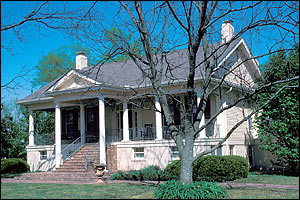Listed in Arkansas Register of Historic Places on 12/06/95
SUMMARY
The Waverly Plantation is being considered for the Arkansas Register of Historic Places under Criterion A as an excellent example of plantation agriculture in Crittenden County.
ELABORATION
According to previous owners of Waverly Plantation, and documented in Margaret Elizabeth Woolfolk's A History of Crittenden County, Arkansas the area around the house used to be an active community known as "Waverly" with many more buildings than those that exist today.
The history of ownership of the property is a rich one. The County Clerk records at Marion indicate that on December 30, 1913 Fontaine Martin Sr. leased the property for three years (1914-1916) from J.S. Williamson who owned a plantation at Edmundson in Crittenden County. A warranty deed dated January 1, 1916 records the sale of 915.55 acres + with a residence and store from Myrtle Lockhart Sloan and husband to Fontaine Martin and his wife Alice Baldwin Martin. The Martin's were a prominent Memphis family who lived at Fontmart, Tennessee (an acronym for Fontaine and Martin) which was fifteen miles east of Memphis on the old Poplar Pike, and is now where Memphis University stands. The Fontaine House on Adams Street N.E. in Memphis is also associated with the family.
Fortunately, Fonatine Martin Sr. wrote an account of his days at Waverly Plantation shortly before his death in 1959, which contains some valuable information about the history of the property. He states that he leased 1200 acres from Mr. Williamson (an ex-sheriff of Crittenden County) in 1913, which he farmed for several years before he decided that it would be better to live on the property. Thus, he and his wife moved to Waverly on January 1, 1915. At that time there was no vehicle bridge across the Mississippi, and the dirt roads were practically impassible in the winter.
Although there were scattered farm commissaries, there was no general store between Hulbert and Hughes. Crittenden County was south of the Rock Island Railroad, but had one branch line of the Iron Mountain Railroad, which made one round-trip per day between Memphis and Marianna, Arkansas and consisted of a few freight cars, and one passenger car. Cotton was the primary crop grown in this area, and Mr. Martin had 49 tenant families to farm his land. The Martins certainly improved the property while they lived there. They drilled an Artesian well, and remodeled the house, which was on the property (to what extent is unknown).
Mr. Martin says that game was extremely plentiful when they lived at Waverly, and said Eastern Arkansas was a hunting and fishing paradise in the early twentieth century. They trapped for mink and otter and sent hundreds of skins to the furriers in St. Louis.
In the 1930s Waverly was purchased by Mr. and Mrs. Milton Baumann. Mr. Baumann invented the retractable landing gear and was forced to leave Waverly during the war. At that time, his brother Roger along with his wife Helen and daughter Elizabeth moved in to Waverly to take care of it in his absence. Milton Baumann and his wife Clara lived at Waverly until they died and they are both buried in the cemetery on the property. The house was inherited by their daughter Elizabeth, and was eventually bought by Mr. John F. and Patricia Thompson Twist who remodeled the buildings and improved the land. The current owners use the property as a weekend/vacation house.
BIBLIOGRAPHY
Information submitted by the owners Mr. and Mrs. Graham and Jeany Smith
Woolfolk, Margaret Elizabeth. A History of Crittenden County, Arkansas. Greenville, S.C.: Southern Historical Press
